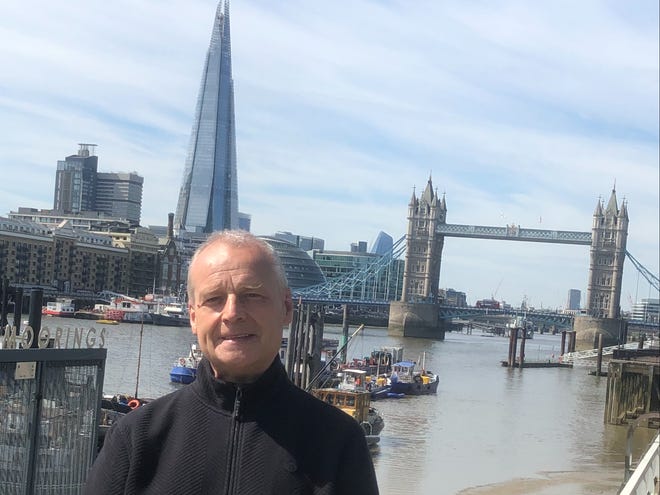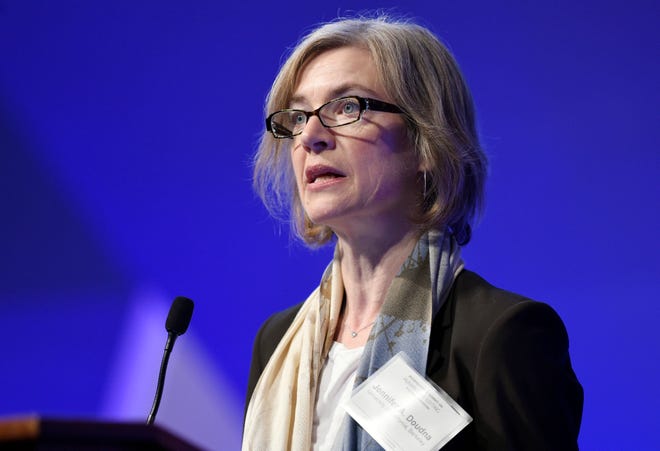Paddy Doherty, of County Donegal, Ireland, recently became the fifth person in the world to have cells deep inside his body altered by the gene-editing tool CRISPR/Cas9.
Two researchers behind CRISPR won the Nobel Prize last year, including American scientist Jennifer Doudna, and it has already been used to edit blood cells removed from the body and infused back in, as well as genes in the eye.
But the trial Doherty participated in was the first time anyone’s whole body has been infused with the CRISPR tool.
It seems to have worked as planned.
In Doherty and five others with the same condition, the one-time treatment appears to have turned off a gene that was causing a fatal build-up of protein in their tissues. The three who got the lowest dose saw more than a 50% decline in their blood levels of the protein, according to a presentation Saturday morning and a publication in The New England Journal of Medicine.
Doherty and two others who got a three-times higher dose, saw an 87% reduction. He thinks he was the one in the group identified as having a 96% reduction.
The current standard treatments for their condition, called transthyretin amyloidosis cause protein reductions of approximately 80%.
The study of six people is obviously small. Its findings need to be repeated in many more people before the so-called NTLA-2001 therapy could be approved for general use, and researchers will need to track patients like Doherty to figure out if one treatment really does last a lifetime.
But if such CRISPR gene-editing continues to show as much promise, the results could herald a new era for transthyretin amyloidosis and dozens of other genetic conditions, including hemophilia, sickle cell disease and a more common trigger for heart failure.
“This is not an incremental advance,” said Fyodor Urnov an expert in gene editing at the University of California, Berkeley who was not involved in the research. “It’s a wow!”
“I’m very enthusiastic,” agreed Dr. Mathew Maurer, an amyloidosis expert at New York-Presbyterian Hospital/Columbia University Medical Center. “I think my patients would be interested in a single, highly-effective therapy, assuming it’s at available at a reasonable cost.”
People shouldn’t be more than “cautiously optimistic,” though, about a treatment that’s only been tested in six people.
“This is very exciting, world-class fantastic science, but we need longer-term follow-up,” Maurer said, adding that it’s not yet clear whether gene editing will improve or extend patients’ lives, or cause unexpected side effects. “We don’t know what the long-term consequences are of this therapeutic approach.”
Gene editing cells inside the body opens the approach up to many more patients, Urnov said. Gene-editing blood outside of the body is useful, but requires something like $5 million in equipment and 10 experts to run that equipment, Urnov said.
Someday, when the science is fully vetted, he said gene editing could help more than 100 million people worldwide with conditions caused by spelling mistakes in their genes.
More:‘A cause for celebration’: New gene editing tool offers promise of treating many genetic diseases
CRIPSR/Cas9 (which stands for Clustered Regularly Interspaced Short Palindromic Repeats and CRISPR-associated endonuclease-9) has mostly been used as a research tool since its 2012 discovery.
But the field, which has been battered by disasters and controversies over the last few decades is still anxiously awaiting more successful results, Urnov said.
“Not one person in my field is doing a victory lap, even around their laboratory bench,” he said. “We’re all slightly blue because we’re all holding our breath.”
Urnov praised the companies developing the new NTLA-2001 treatment, Intellia Therapeutics of Cambridge, Massachusetts, and Regeneron Pharmaceuticals, Inc. of Tarrytown, New York, for developing a safer approach to CRISPR gene editing.
“What Intellia did very smartly,” Urnov said, is “they worked out how to deliver CRISPR in a way where it lurks for only a few days.”

Signs of trouble
The breathlessness on a hillside walk last fall wasn’t Doherty’s first sign of trouble, but it was the one that finally got him to go to the doctor.
Doherty, 65, a mechanical engineer, lost his father at age 67, and two uncles died young, too.
After months of appointments and scans, Doherty ended up with a devastating diagnosis: an inherited form of a disease called transthyretin amyloidosis with polyneuropathy. It meant clumps of proteins were slowly clogging up his heart and nerves, and after years of pain and progressive heart failure, would kill him.
Of course, his next question was what could be done about it.
In the United States and Europe, drugs given by infusion every three weeks for life can reduce the protein build-up and reverse or at least slow the course of transthyretin amyloidosis. But because of a legal quirk, the treatments aren’t accessible to patients in Ireland or New Zealand.
So, in February, Doherty found himself in the office of Dr. Julian Gillmore, an amyloidosis expert at the Royal Free Hospital in London and University College London.
Gillmore offered him the chance to become one of the first patients to receive an infusion containing the gene-editing tool CRISPR.
“A one-hit wonder,” as Doherty described it. “A two-hour process and that’s it for the rest of your life.”
The more Doherty looked into it, the more impressed he was with the technology. “I loved the two women that got the Nobel,” he said, praising Doudna in particular, for raising ethical questions about how her gene-editing tool might be misused.
Gillmore, who has been working with amyloidosis patients for a quarter century, said it’s been “amazingly exciting” to see the trial results and be able to treat people like Doherty, who otherwise wouldn’t have gotten adequate care.
“Just to see the hope for the patients when after so many years you haven’t seen that – it’s what keeps you doing what you’re doing,” Gillmore said.
The CRISPR era has begun
Gillmore said he’s seen many families like Doherty’s “decimated” by the disorder, as the misfolded protein deposits in their tissues. His form of the disease causes progressive heart failure, incontinence, constant pain, including in the feet, making it hard to walk. Once symptoms begin, they die within 5 to 10 years after passing it on to their children.
“Until maybe five years ago, there was nothing we could do to alter the natural history of the condition,” he said.
Then a few companies came out with drugs that silenced the gene causing the toxic build-up. These drugs provide dramatic improvements in some patients but little to no benefit in others. “They’re certainly not a panacea,” Gillmore said, and they have to be taken by infusion every three weeks for life.
The CRISPR gene-editing approach, by contrast, seems to knock down the concentration of the protein that forms the amyloid build-up. Although protein has already built up in patients like Doherty who have symptoms, hopefully, by dramatically cutting down on new build-up, the body will be able to clear out what’s already accumulated.
It’s too soon to know whether the treatment will reduce patient symptoms or extend their lives – but Gillmore is hopeful. “We know from every type of amyloid we’ve ever treated that the more we knock down the protein, the better patients do,” he said.
A non-hereditary form of amyloidosis appears to be a major cause of heart failure in people over 50, he said, and may also be treatable with NTLA-2001. “It should absolutely work for that on the basis of everything we know about amyloid,” Gillmore said. (The protein clumps in amyloidosis are made of a different protein than the amyloid clumps seen in Alzheimer’s, so the approach will not work for that disease.)
Patients have fared well on NTLA-2001 so far, with no serious side effects.

This early in the clinical trial process, there are still risks that could appear. The fix could turn out to be temporary or something else unexpected could happen, Gillmore noted. “It’s incredibly exciting, but of course, we need a significant degree of caution at this point.”
Asked if he was worried about the rest of the testing, which will include a higher dose and many more patients, he said: “I’m sleeping very well, thank you.”
NTLA-2001 is infused into the bloodstream, but is designed to deliver its payload into the liver, which Urnov described as “the Port Authority of the body,” because everything passes through it.pl;
The genes that cause amyloidosis function primarily in the liver, said Dr. John Leonard, Intellia’s president and CEO. That’s what made transthyretin amyloidosis with polyneuropathy a good first target for CRISPR gene editing. “What we need to go after is in a place we can get to,” he said.
The trial, run by Richmond Pharmacology, a London-based clinical research organization, has already proven that it’s possible to edit genes deep inside their body with CRISPR. “The broader question about CRISPR has now been answered,”
Leonard said. “You can inactivate a gene.”
Leonard said Intellia, co-founded by Nobel laureate Doudna, will move as quickly as possible to shepherd NTLA-2001 through the Food and Drug Administration’s approval process. It is also beginning gene editing studies in patients with hereditary angioedema, which can cause swelling in different body parts, including potentially fatal swelling of the windpipe.
The same gene-editing approach also holds promise for adding back proteins, he said, in diseases such as hemophilia and sickle cell.
Last week, Editas Medicine, Inc. another genome editing company based in Cambridge, enrolled the first children in a trial designed to test CRISPR editing in a hereditary cause of blindness called Leber congenital amaurosis 10. The treatment has already been shown safe in adults.
“The promise is starting to be realized in actual patients who benefit from an approach that didn’t exist a few years ago,” Leonard said. “Now, we can start to think about going after medical problems we could never pursue previously … The CRISPR era is upon us.”
Paddy Doherty said he’s excited too about becoming part of the CRISPR story.
The new treatment offers the possibility that his relatives and others won’t have to live with the disease.
“The big thing that happens when you get the diagnosis – your first thought is on your kids. You don’t think about yourself at all,” said Doherty, who has two daughters. “It’s a lonely place when you get a diagnosis like this.”
Contact Karen Weintraub at kweintraub@usatoday.com.
Health and patient safety coverage at USA TODAY is made possible in part by a grant from the Masimo Foundation for Ethics, Innovation and Competition in Healthcare. The Masimo Foundation does not provide editorial input.